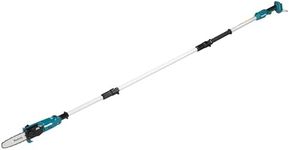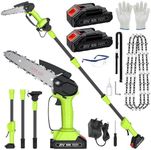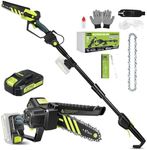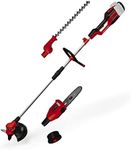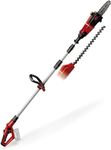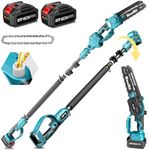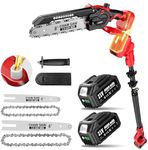Buying Guide for the Best Pole Saws
Choosing the right pole saw can make a significant difference in your gardening and landscaping tasks. A pole saw is essentially a small chainsaw on an extendable pole, designed to help you trim and prune branches that are out of reach. When selecting a pole saw, it's important to consider several key specifications to ensure you get the best fit for your needs. Understanding these specifications will help you make an informed decision and find a pole saw that is efficient, safe, and easy to use.Power SourceThe power source of a pole saw determines how it operates and its suitability for different tasks. Pole saws can be powered by gas, electricity, or batteries. Gas-powered pole saws are typically the most powerful and are suitable for heavy-duty tasks, but they are also the heaviest and require more maintenance. Electric pole saws are lighter and easier to maintain, making them ideal for medium-duty tasks, but they require access to a power outlet. Battery-powered pole saws offer the most convenience and mobility, making them perfect for light to medium tasks, but their runtime is limited by battery life. Choose a power source based on the type and frequency of tasks you plan to perform.
Bar LengthThe bar length of a pole saw refers to the length of the cutting blade. This specification is important because it determines the maximum diameter of branches the saw can cut. Bar lengths typically range from 6 to 12 inches. A shorter bar length (6-8 inches) is suitable for light pruning and trimming smaller branches, while a longer bar length (10-12 inches) is better for cutting thicker branches. Consider the size of the branches you will be cutting most often to choose the appropriate bar length.
Pole LengthPole length is the maximum length the pole can extend to, which affects how high you can reach with the saw. Pole lengths usually range from 8 to 15 feet. A shorter pole length (8-10 feet) is sufficient for most residential tasks and easier to handle, while a longer pole length (12-15 feet) is better for reaching higher branches but can be more challenging to control. Assess the height of the trees and branches you need to trim to determine the right pole length for your needs.
WeightThe weight of a pole saw affects how easy it is to handle and maneuver. Heavier pole saws can be more difficult to use for extended periods, especially when working overhead. Weights can vary significantly depending on the power source and construction materials. Lighter pole saws (under 10 pounds) are easier to handle and reduce fatigue, making them ideal for occasional use. Heavier pole saws (over 10 pounds) may offer more power and durability but can be tiring to use. Consider your physical strength and the duration of your tasks when choosing the weight of your pole saw.
Cutting CapacityCutting capacity refers to the maximum diameter of branches the pole saw can effectively cut. This is influenced by the bar length and the power of the saw. Cutting capacities typically range from 4 to 8 inches. A smaller cutting capacity (4-6 inches) is suitable for light pruning and smaller branches, while a larger cutting capacity (6-8 inches) is better for thicker branches and more demanding tasks. Think about the typical size of the branches you will be cutting to select a pole saw with the appropriate cutting capacity.
Ease of UseEase of use encompasses several factors, including the design of the pole saw, its balance, and additional features like automatic oiling, tool-less chain tensioning, and ergonomic handles. These features can make the pole saw more comfortable and convenient to use. Look for a pole saw that offers a good balance between the saw and the pole, as well as features that simplify maintenance and operation. Consider how often you will use the pole saw and your comfort level with handling garden tools to choose a model that is easy to use.

